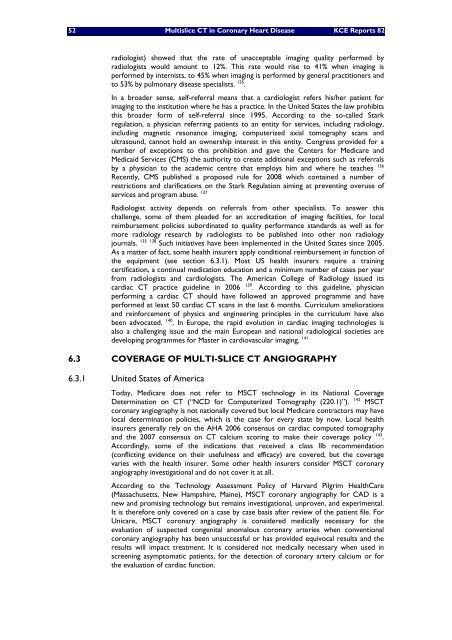Download the full report (116 p.) - KCE
Download the full report (116 p.) - KCE
Download the full report (116 p.) - KCE
You also want an ePaper? Increase the reach of your titles
YUMPU automatically turns print PDFs into web optimized ePapers that Google loves.
52 Multislice CT in Coronary Heart Disease <strong>KCE</strong> Reports 82<br />
radiologist) showed that <strong>the</strong> rate of unacceptable imaging quality performed by<br />
radiologists would amount to 12%. This rate would rise to 41% when imaging is<br />
performed by internists, to 45% when imaging is performed by general practitioners and<br />
to 53% by pulmonary disease specialists. 135 .<br />
In a broader sense, self-referral means that a cardiologist refers his/her patient for<br />
imaging to <strong>the</strong> institution where he has a practice. In <strong>the</strong> United States <strong>the</strong> law prohibits<br />
this broader form of self-referral since 1995. According to <strong>the</strong> so-called Stark<br />
regulation, a physician referring patients to an entity for services, including radiology,<br />
including magnetic resonance imaging, computerized axial tomography scans and<br />
ultrasound, cannot hold an ownership interest in this entity. Congress provided for a<br />
number of exceptions to this prohibition and gave <strong>the</strong> Centers for Medicare and<br />
Medicaid Services (CMS) <strong>the</strong> authority to create additional exceptions such as referrals<br />
by a physician to <strong>the</strong> academic centre that employs him and where he teaches 136<br />
Recently, CMS published a proposed rule for 2008 which contained a number of<br />
restrictions and clarifications on <strong>the</strong> Stark Regulation aiming at preventing overuse of<br />
services and program abuse. 137<br />
Radiologist activity depends on referrals from o<strong>the</strong>r specialists. To answer this<br />
challenge, some of <strong>the</strong>m pleaded for an accreditation of imaging facilities, for local<br />
reimbursement policies subordinated to quality performance standards as well as for<br />
more radiology research by radiologists to be published into o<strong>the</strong>r non radiology<br />
journals. 135 138 Such initiatives have been implemented in <strong>the</strong> United States since 2005.<br />
As a matter of fact, some health insurers apply conditional reimbursement in function of<br />
<strong>the</strong> equipment (see section 6.3.1). Most US health insurers require a training<br />
certification, a continual medication education and a minimum number of cases per year<br />
from radiologists and cardiologists. The American College of Radiology issued its<br />
cardiac CT practice guideline in 2006 139 . According to this guideline, physician<br />
performing a cardiac CT should have followed an approved programme and have<br />
performed at least 50 cardiac CT scans in <strong>the</strong> last 6 months. Curriculum ameliorations<br />
and reinforcement of physics and engineering principles in <strong>the</strong> curriculum have also<br />
been advocated. 140 . In Europe, <strong>the</strong> rapid evolution in cardiac imaging technologies is<br />
also a challenging issue and <strong>the</strong> main European and national radiological societies are<br />
developing programmes for Master in cardiovascular imaging. 141<br />
6.3 COVERAGE OF MULTI-SLICE CT ANGIOGRAPHY<br />
6.3.1 United States of America<br />
Today, Medicare does not refer to MSCT technology in its National Coverage<br />
Determination on CT (“NCD for Computerized Tomography (220.1)”). 142 MSCT<br />
coronary angiography is not nationally covered but local Medicare contractors may have<br />
local determination policies, which is <strong>the</strong> case for every state by now. Local health<br />
insurers generally rely on <strong>the</strong> AHA 2006 consensus on cardiac computed tomography<br />
and <strong>the</strong> 2007 consensus on CT calcium scoring to make <strong>the</strong>ir coverage policy 143 .<br />
Accordingly, some of <strong>the</strong> indications that received a class IIb recommendation<br />
(conflicting evidence on <strong>the</strong>ir usefulness and efficacy) are covered, but <strong>the</strong> coverage<br />
varies with <strong>the</strong> health insurer. Some o<strong>the</strong>r health insurers consider MSCT coronary<br />
angiography investigational and do not cover it at all.<br />
According to <strong>the</strong> Technology Assessment Policy of Harvard Pilgrim HealthCare<br />
(Massachusetts, New Hampshire, Maine), MSCT coronary angiography for CAD is a<br />
new and promising technology but remains investigational, unproven, and experimental.<br />
It is <strong>the</strong>refore only covered on a case by case basis after review of <strong>the</strong> patient file. For<br />
Unicare, MSCT coronary angiography is considered medically necessary for <strong>the</strong><br />
evaluation of suspected congenital anomalous coronary arteries when conventional<br />
coronary angiography has been unsuccessful or has provided equivocal results and <strong>the</strong><br />
results will impact treatment. It is considered not medically necessary when used in<br />
screening asymptomatic patients, for <strong>the</strong> detection of coronary artery calcium or for<br />
<strong>the</strong> evaluation of cardiac function.

















